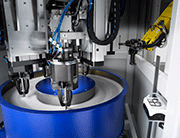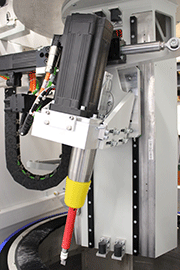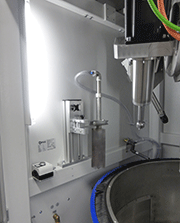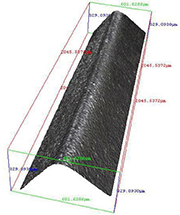E-Archive
Articles
in Vol. 16 - May Issue - Year 2015
The Stream Finishing Machine For Series Production

Automatic loading of the SF machine

Alternating direction of rotation

The angle of incidence can be adjusted by means of a servo motor

Suction nozzle for extracting the wastewater

Before finishing

Before finishing

After finishing

After finishing
OTEC is a medium-sized manufacturer of drag finishing, disc finishing and stream finishing machines. Founded by Helmut Gegenheimer in 1996, the company has steadily established itself on the market by developing innovative new machine concepts and numerous patented processes. Initially this was in the jewellery industry, then increasingly in the tool making, pharmaceutical and automobile industries as well as in the areas of medical devices and CNC machining. The key to success has always been the development of new, better solutions, which have proven to be superior to previous surface finishing processes. Today, OTEC is the technological leader in many markets and maintains a network of branches worldwide.
OTEC has developed the new SF 3/105 immersion finishing unit with pulse drive system specially to enable the system to be fully integrated into production lines for large-scale production runs. This unit type enables complex turned parts such as worm drives, cogwheels and camshafts to be deburred, rounded, burnished or polished in a matter of seconds. It is a very easy matter to adjust the unit to the production cycle time, which is often only a few seconds.
How the machine works
The workpieces are clamped by means of a mandrel or similar device. Loading can be carried out manually, by the use of a handling system or by a robot (especially for series production). Processing is carried out by immersing the workpiece in a flowing stream of grinding or polishing medium. The media stream is generated by means of a rotating drum with a diameter of up to 1.05 m. The laminar flow velocity of up to 15 m/s ensures very short processing times.
The pulse drive
The pulse drive system developed by OTEC delivers perfect results by constantly alternating the direction of rotation. During this process, the clamped workpiece is immersed in a media stream of grinding or polishing medium where it is alternately processed in each direction of rotation in a stream of grinding or polishing media. Decelerating and accelerating again to 2,000 rpm takes only half a second. This creates relative velocities of up to 30m/s and accelerations of up to 40 g. The main advantage of this is extremely short finishing times.
Additional features
The angle of incidence can be adjusted by means of a servo motor and is therefore variable. It can be changed automatically during the finishing process. Predefined positions can be transferred, inputted to, and stored in the program. This enables the flow to be adjusted to the precise requirements of the workpiece.
A suction nozzle is fitted to continuously pump out the wastewater and the sludge from the wet finishing process. The benefits of this system are obvious:
Constantly high rates of material removal
No sludge in the process drum
Grinding and polishing media are always kept clean
Clean workpieces
Example: finishing of forcer
Task description:
Debur and round the edges to approx. 70 ìm whilst at the same time smoothing the surface from Ra 0.4 to below 0.2 ìm.
Result:
The processing time required was approx. 30 seconds. This means that with an SF 3 with three pulse drives, one workpiece would be finished every 15 seconds.
For Information:
OTEC Präzisionsfinish GmbH
Dieselstrasse 8 - 12
75334 Straubenhardt-Feldrennach, Germany
Tel. +49.7082.4911 20
Fax +49.7082.4911 29
E-mail: info@otec.de
www.otec.de



























